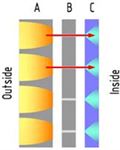
 Professor Roland Winston’s work has helped take UC Merced and UC Solar global – this time it’s to Singapore.
Professor Roland Winston’s work has helped take UC Merced and UC Solar global – this time it’s to Singapore.
The small city-nation is experiencing a building boom, and developers have plans to use Winston’s designs for a solar collector to make concrete walls the source of building light.
Sounds impossible, right?
Collectors embedded in the concrete at the ends of open channels in the walls would make the concrete light-permeable, cutting down on the need for electric lights and taking advantage of one natural resource the equatorial country has an abundance of – sun.
“It cuts down on electrical use and makes a more pleasant environment. This would actually be a cooler light source, too,” said Winston, director of UC Solar. “The collectors filter out ultraviolet light, which is bad for your skin, and infrared light, which is hot. And studies show people perform better in rooms that are naturally lit.”
 Winston recently returned from serving as keynote speaker at a conference in Singapore, and said he was surprised at how prosperous the republic, made up of more than 60 islands and more than 5 million people, is.
Winston recently returned from serving as keynote speaker at a conference in Singapore, and said he was surprised at how prosperous the republic, made up of more than 60 islands and more than 5 million people, is.
Singapore is known as one of the four Asian Tigers, along with Hong Kong, Taiwan and South Korea, because of their highly developed economies. Singapore is a leading international financial center, has one of the world’s five busiest ports and is home to a lot of varied manufacturing, as well as a very diverse population.
It’s also an expensive place to live.
“Their energy costs are more than double what we pay,” Winston said.
But Singapore is a green, progressive place, he said, as evidenced by the desire to use solar energy in new and inventive ways.
“This is an example of what you can do when you have a strong, socially directed group,” he said.
Singapore isn’t just interested in the light-permeable technology – which is being tested at UC Berkeley before being sent across the Pacific, either.
Nanyang Technical University also plans to use one of Winston’s designs to implement a solar-powered thermal cooling system similar to the one used at the Castle Research Facility where UC Solar is headquartered.
The Singapore system will use solar energy to chill water that will run across panels in the building’s ceiling, keeping rooms much cooler because cold air falls. When there’s not enough sun, the system uses natural gas, but it will dramatically cut down on natural gas use, which is good for Singapore, where natural gas is four to five times more expensive than in the United States, Winston said.
The system being installed in Singapore is even more efficient than blowing air across cold-water pipes, as is done at Castle.
Winston, a professor with the schools of Natural Sciences and Engineering, said UC Solar will send students to help Nanyang build its cooling system. They will set up the solar collector and gather data about its use in the tropical environment of Singapore. The plan is to have it up and running this year, and if Nanyang officials like the results, they will likely expand the cooling system across their campus.
“Now they know about UC Merced in Singapore,” Winston said. “I think it’s kind of neat to have outreach so far away.”
Lorena Anderson

Senior Writer and Public Information Representative
Office: (209) 228-4406
Mobile: (209) 201-6255






